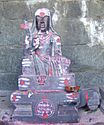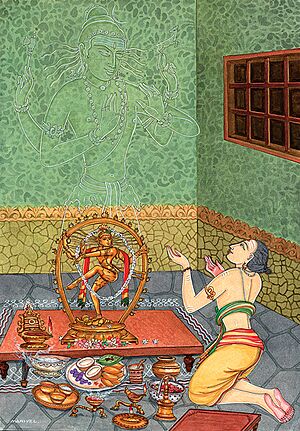Murti facts for kids
Murti (idols, images) of different deities and saints
|
||||||||
In Hinduism, a murti is a special image or statue. It represents a god, saint, or a divine idea. You can find murti in Hindu temples and homes. They are important symbols for people who follow the Hindu faith.
A murti is not the god itself. Instead, it is a way to focus on the god's qualities or presence. Think of it like a photograph of a loved one. The photo isn't the person, but it helps you remember and connect with them. Murti help people connect with the divine.
What is a Murti?
A murti is usually a statue or an idol. It is made from materials like stone, wood, or metal. Sometimes, they are made from clay or pottery. These images are carefully crafted. Ancient texts guide how they should look. They describe the right shapes, hand gestures, and body positions.
Different Kinds of Murti
Murti can show different feelings or ideas. Some murti look fierce or powerful. These are called ugra forms. They represent strength, protection, or the destruction of evil. Examples include Durga or Kali.
Other murti look calm, joyful, or wise. These are called saumya forms. They represent peace, knowledge, and happiness. Saraswati (goddess of knowledge) and Lakshmi (goddess of wealth) are examples. Most murti found in temples are saumya forms. Another type of murti is the lingam, which is a symbolic representation of Shiva.
How Murti are Used
Murti are used in religious practices. In homes and temples, they are part of puja. This is a special worship ritual. During puja, people offer prayers, flowers, and food to the murti. They treat the murti like a respected guest.
Sometimes, murti are carried in special parades. These parades happen during festivals. These moving murti are called utsava murti. They allow many people to see and honor the deity. The earliest mentions of murti go back to the 4th century BCE.
Murti can also be called vigraha or pratima. These words all mean a form or image of a deity.
Images for kids
-
Men carving stone idols or murti. Mahabalipuram. 2010
-
A collection of modern-day murti featuring the elephant-headed God, Lord Ganesha.
-
8th-century ivory murti parts from Kashmir. Many temples and sculptures were built and later destroyed in Kashmir. Some murti were kept safe in Tibetan Buddhist monasteries.
See also
 In Spanish: Murti para niños
In Spanish: Murti para niños











